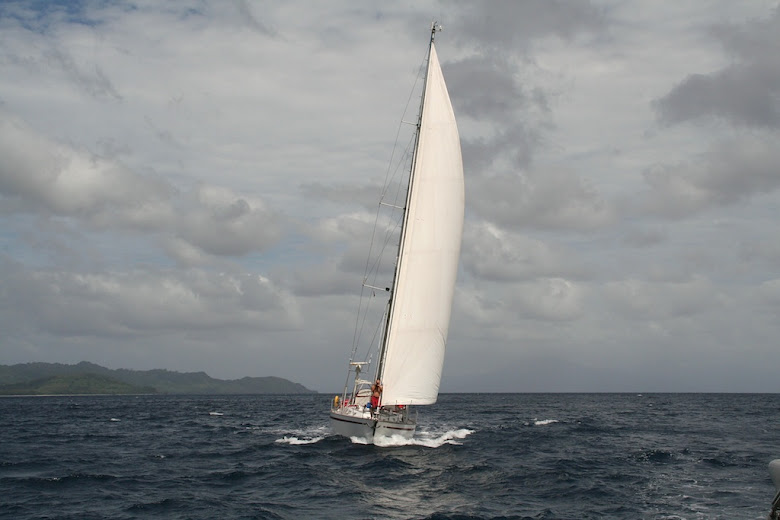Looking at the weather we saw nothing nice coming and it seemed that if we wanted to leave Velas within the next five days, that we should return the car in the morning and sail to Horta, with the wind still from Southeast. Later Southwesterlies lasting for at least 4 days were forecast.
In theory we could also have used the SE t get to Flores, but there the weather would be even worse and certainly no good to explore the island. So we thought we better be weather locked in Horta, with more possibilities ashore even on a rainy day.
We also hoped that the bulk of the boats that wanted to go to northern Europe, would use this opportunity and leave, so the the marina would not be totally filled. So, on Thursday, June 21 we cleared out again in Velas and headed across the channel towards Horta. Near Pico the wind accelerated and then dropped to nothing. Only to pick up from the other side some 3 miles further. Put up quite a wave in the channel between Faial and Pico and the clouds driven around the big volcano on Pico looked really spectacular.
Our guess was wrong, no boats had left or where leaving Horta and the Marina was bursting, with boats rafting up 4 deep, in the marina and on the long reception stone wall. So we decided to anchor in the harbor and clear in with the dinghy. The guy in the marina confirmed, that we could possible raft up somewhere, but no decent space was available and so we chose to stay anchored for a day or two and then check again.
Now it is a week and we are still anchored in the harbor. At first more and more boats arrived and none left for three days. The weather got ugly and gusty winds were driving through the harbor. There was a lot to see off course, overlooking the entire harbor basin from our vantage point on Taniwani. The ground is very foul and rocky, so many boats had problems with their anchors. Two times we saw another boat bringing up an orphan SQR anchor with chain on it, but now boat obviously attached to it. A swiss Amel dragged her anchor with nobody on board, left the harbor and was just on the rocks of the marina breakwater, when two other Yachties saw it and got on the boat in the last minute. Fortunately they were able to start the engine and bring the boat back in where they anchored her. A totally astounded owner showed up when they were just finishing the anchoring maneuver. I don't think he ever realized that his boats was already on the rocks.
The night from Sunday to Monday was worst with wild gusts blowing through the harbor, yanking the boats around on their anchors. By now it seems all anchors had found something to hold on to. Certainly Taniwani didn't move an inch. Still we were up in the cockpit around midnight, just to see what is going on, when a panicked Mayday call came in on VHF. A frightened women's voice just crying Mayday. Came up twice, with no more info and then did not respond to any inquiries any more. You were wondering what had happened to the poor folks, and the cries were still in our ears for some hours.
Two days later we read in the local news, that a french yacht with a couple had stranded on the south coast of the island. Not a nice looking shore as we know. They must have been caught by surprise and somehow, with the help of the local fire brigade they were safely brought ashore and to the hospital.
Monday the weather cleared up again, the wind went to NW and many boats started to leave. By now there are still boats rafted in the marina, but only two deep on average. It would certainly be possible to get a good place in the marina, but we didn't ask any more. Used to be at anchor we enjoy it out here.
Driven by curiosity, I went snorkeling to look what our anchor found to hold on to. I found our anchor deeply engaged with a steamer size chain, which it had dragged under a big rock. While we could possible have lifted the big chain with our strong windlass, so that we could get a rope underneath to free our anchor, it would not have been possible to pull up the anchor the way it was locked under the rock. I had to attach a line to the anchor and have Beate pull it back from the rock using the dinghy at full reverse, while I went down to wedge the chain out from behind the flukes.
Finally I moved the anchor over the chain towards the ship, that way it may not be holding the next storm, but we could get it up easily we thought. Well, today the wind picked up from the north this may well drag the anchor back into the chain in the other direction. We shall see. At least we are safe here.
Weather is still nowhere near perfect, but we think, with the northerly winds we should be able to just about lay course for Flores. If the reports don't change significantly, we plan to leave tomorrow Friday afternoon, and sail over night to Flores. Stay tuned….






















































